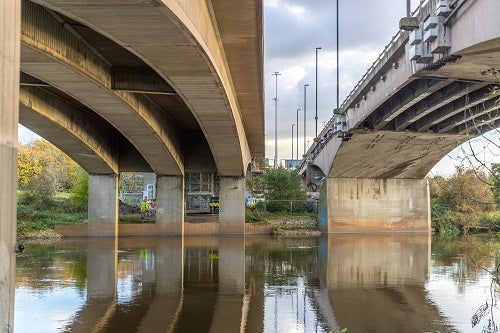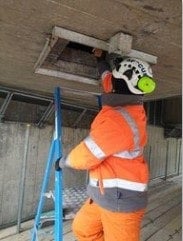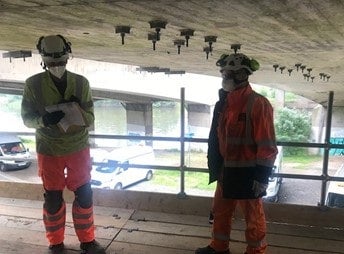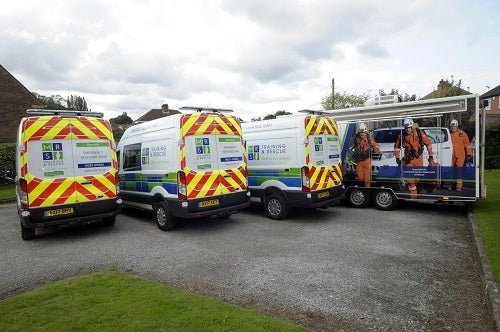There has been much in the media recently regarding fears over the condition of bridges throughout the UK.
A recent report by The Times newspaper, written from data obtained from Highways England under the freedom of information act, highlighted 4,000 bridges located on the UK’s busiest roads were in a poor condition and needed urgent repair work. Of these, 858 bridges were found to have at least one load-bearing or other vital section in “very poor condition”.
Whilst these findings do not necessarily mean bridges are unsafe, it may mean weight restrictions need imposing on them until repairs can be carried out. And traffic management systems, including lane closures, may also need putting in place to facilitate the maintenance work. The lower traffic levels seen because of the coronavirus pandemic provide an opportunity to fix issues and cause less disruption on the roads for motorists.
However, in some cases, bridges have had to be completely closed. As is the case for the Hammersmith Suspension Bridge in London, which closed to motorised traffic in April 2019 when engineers found hairline fractures in the cast iron pedestals. This bridge was closed altogether in August 2020 due to widening cracks appearing and it is likely the bridge will be closed for many years yet, to enable extensive repair work to be carried out. This is an extreme example, and whilst London Bridges may not be necessarily falling down, the report states that 200 out of 500 bridges and other structures in the capital also have key sections in "poor" or "very poor" condition.
According to Highways England guidelines, structures must undergo a general inspection every two years, and a more detailed principal inspection every six years. Around 10,000 inspections are done each year, addressing issues such as the condition of the paint, through to the integrity of the structure itself.

Bridges and Confined Spaces
These routine inspections can involve persons having to enter and work inside the bridge structure to carry out the inspections. Many bridges have confined spaces within them – for example, the inside of Segmental Bridges and in Enclosed Bridge Columns. Such confined spaces encountered during bridge maintenance work present safety hazards that require mitigating to keep workers safe.
The Confined Spaces Regulations 1997 requires those working in confined spaces to be trained and competent. When considering if the space is a confined space, it may not be the actual nature of the space, but the planned work activities that determine if it should be classified as a confined space. Such activities can introduce risk including noxious fumes, reduced oxygen levels, a risk of fire or explosion, risk of flooding/drowning or asphyxiation from some other source such as dust, grain or other free-flowing solid. Also, the physical dimensions, layout and restricted access and egress inside the bridge sections can make it difficult to self-escape or deal with an injury or illness that would, in normal situations, be much easier to deal with.
Multiple landing entry and exit into a confined space can introduce additional issues that will need to be considered during the process of risk assessment.These will include, but are not limited to:
- Communication
- Access and egress
- Working at height
- No direct lift for casualty recovery (or restricted access for casualty recovery)
- Gases, fumes etc at different levels
- Heat rising inside the bridge sections, particularly in the summer months
Consideration should also be given to the type of equipment that is being used and may include the use of additional control measures such as the method of fall arrest, whilst special consideration will need to be given to how casualties may be recovered. This may include the use of specialist confined space rescue stretchers and extrication devices, along with advanced first aid skills and equipment, due to the potential for a delayed exit and wait for further local authority emergency backup, which in itself may be further delayed due to specialist help being on another call or having to wait for specialist services from further afield. Because of this, the Confined Space Regulations L101 ACOP section5: 147states:
You must make suitable arrangements for emergency rescue which will depend on the nature of the emergency rescue, you should not rely on the public emergency service. You should consider accidents arising from a specified risk, and any other accident in which a person needs to be recovered from a confined space, for example incapacitation following a fall. To be suitable and sufficient the arrangements for rescue and resuscitation should cover:
- Rescue and resuscitation equipment
- Raising the alarm and rescue
- Safeguarding the rescuers
- Fire safety
- Public emergency services
- Training
Many bridges have vast spaces inside the structure and for maintenance work to be carried out may either require scaffolding erected to enter the space or scaffolding inside the bridge to access all areas required.
Confined Space Consultancy for Bridges
At MRS Training & Rescue, we offer a confined space consultancy service for industry, to assess the space and work to be carried out, to determine if the space does constitute a confined space and if so, the risk level involved. Our experience of working in high-risk environments, combined with specialist skills in confined spaces and working at height have made us a perfect partner for many companies undertaking bridge repairs.

One such project has been with Highways England to provide rescue cover for bridge repair works being undertaken on the A52 Clifton Bridge in Nottingham. We have also provided first aid cover and rescue from height support during the operation.
That is not where our experience ends, we have provided support to the length and breadth of the country - including Tinsley Viaduct, Wroxham Bridge, and Framwellgate Bridge for Durham Council are a few examples.
For many of these projects, we have not only provided confined space consultancy during the initial inspection but also, once we have a full understanding of the unique requirements of the site and work being carried out, we have provided help and expertise in completing the necessary RAMS documentation commonly associated with confined space working, that together form a safe system of work.
These can include:
- Risk assessment
- Method statement
- Permit to work
- Rescue plan (emergency arrangements)
These documents, if used correctly, will minimise the risk of something going dramatically wrong when undertaking confined space work.

Furthermore, due to the nature of the confined space or the hazards which are present, we have also provided specialist emergency rescue and recovery teams on site. These dedicated teams are on hand to carry out a rescue from within the confined space should the need arise. Able to use resuscitation equipment, rope, and rope access to recover casualties and operate in breathing apparatus, our skilled operatives:
- Ensure that the roles, responsibilities, and requirements detailed in the scope are fulfilled
- Take the time to fully understand the customer requirements so we deliver benefits from day one
- Act as the interface between the customer and MRS Training & Rescue stakeholders, using our resource and expertise
- Maintain compliance to agreed KPIs and Service levels
- Keep the customer up to date with changing compliance requirements
- Bring insight in the health and safety arena which MRS Training & Rescue is exposed to on a day-to-day basis and bring the proactive leadership that can implement change where appropriate
- Identify areas of additional value, e.g., in changes to best practice.
- Be responsible for preparing and agreeing the risk assessment and the safe system of work with the responsible person identified by the customer
We can also run a simulated exercise to ensure the agreed arrangements work practically (providing confidence and evidence to those carrying the work activities).
All our vehicles are suitable for highway maintenance with Chapter 8 signage and amber flashing lights as standard, and our teams also carry life jackets and flotation devices for any bridgework taking place over water.

In the event of an emergency occurring, our specialist teams:
- Know the emergency procedures to be followed
- Check equipment is fit for purpose
- Be available for immediate response in an emergency
- Enter the confined space in an emergency
- Locate the casualty
- Safely evacuate the casualty from the confined space
- Complete reports
Contact MRS Training & Rescue
If you would like to learn more about MRS Training & Rescue and the services we provide, don’t hesitate to contact us.




